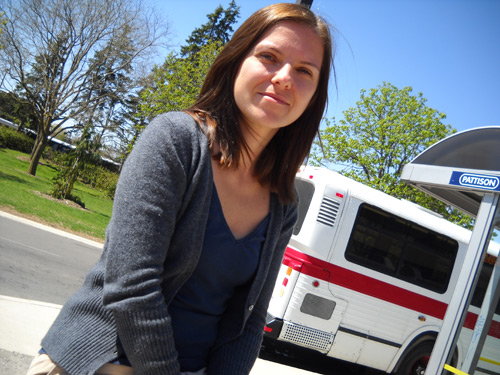
In the great transit game, are you a person or a pawn? Finding ways to make urban transit spaces look and feel more like inviting urban squares is the goal of research by a Guelph master’s student in landscape architecture.
Mention airports, train stations or bus depots, and many people might think of impersonal, featureless spaces closer to purgatory than to paradise, says Ana Cruceru, School of Environmental Design and Rural Development (SEDRD).
“You’re looking with dread at the time you’re spending there, you’re confined to that space, you don’t have much to do, you’re probably stressed out,” says Cruceru, who has seen her share of transit terminals since she left her native Romania four years ago.
She suggests those transit spaces might represent more than just an expediting corridor between routes. And softening all those hard edges might involve importing the features and feel of urban squares and even gardens.
Take Kuala Lumpur International Airport in Malaysia, whose main terminal building contains a slice of rainforest transplanted from the surrounding jungle. Or look at the atrium of Madrid’s Atocha train station with its mini tropical garden. Then contrast those spaces with the “series of corridors” in Rome’s Fiumicino Airport. There’s plenty of glass to lighten up the space, but there’s little to see outside beyond tarmac and airplanes.
Introducing gardens or garden elements is one way to make transit space more personal, says Cruceru. And that need not apply only to air terminals. She mentions the transit depot in front of the University Centre, where she catches a city bus to go home. Often she finds her eyes and mind drawn across the pavement to the island of green space within the transit loop.
Another idea borrows from public areas consisting of varied smaller spaces, she says. That approach offers options for passersby to join the bustle or to remain apart from it. There’s something respectful in providing that choice, says Cruceru. “I see it as a more democratic space.”
Cruceru says she’s not a fan, however, of St. George’s Square in downtown Guelph. She thinks that space lacks a strong identity and hides many of its historical features behind more utilitarian facades. Public spaces should reflect the character, heritage or culture of the location or city, says Cruceru.
Although bias may creep in, she points approvingly to her hometown of Bistrita in northern Romania. Like many European centres, the downtown focuses on the market square, framed by historical buildings, including a cathedral.
“You can tell when you’re downtown,” says Cruceru. “It’s a very theatrical sort of urban space. It has these visual elements that provide a sense of drama, where you feel in the centre of things.”
Based on her research, which is supervised by SEDRD professor Nate Perkins, Cruceru says public transit will continue to grow as municipalities introduce urban intensification and energy-efficient transportation. But she insists that “efficient” need not mean utilitarian. Why not turn a bus stop into something more than just a bus stop? Imagine incorporating elements for children to play or learn, she says, or perhaps including narrative or artworks that reflect the neighbourhood, even an intriguing design on mosaic floor tiles.
“It’s the temporary quality of the experience within transit spaces that I find most intriguing and the undetermined potential for a whole other range of experiences within them,” she says. “The space should address more than the need of travellers to wait for the next connection. Are you just a piece in this interchanging game or a person?”